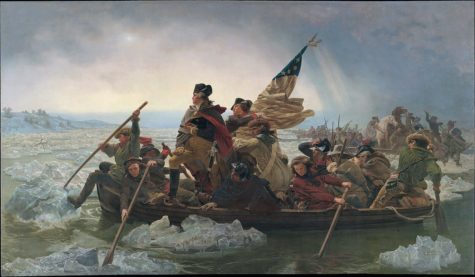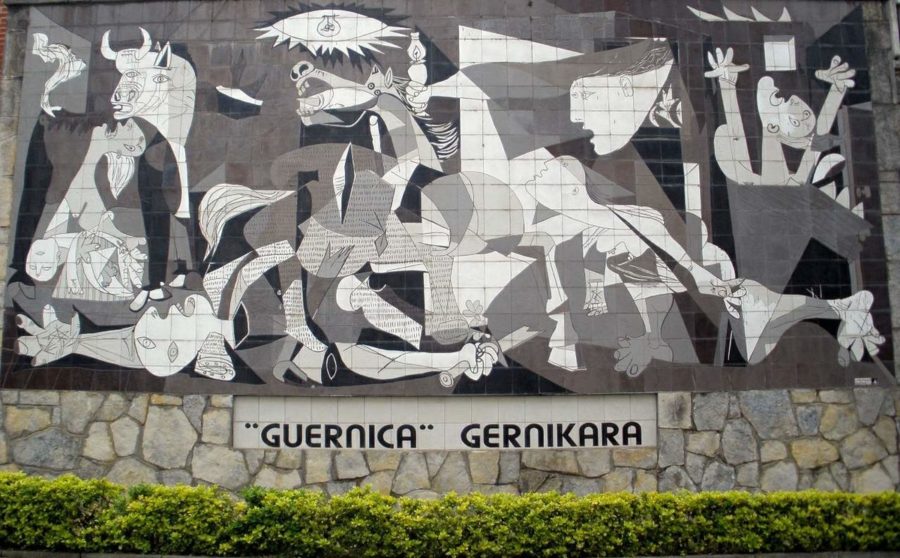How Does War Affect our Artistic Expression?
Throughout history, people have turned to art to express their feelings towards war and conflict.
Zarateman, CC0, via Wikimedia Commons
Pablo Picasso’s Guernica painting contains numerous symbols, including a bull, horse, soldier, and mother cradling her child. “Part of Guernica’s strength lies in the massive variety of abstract metaphors and symbols it contains. Any one of the facets of its composition can be picked apart and interpreted in a myriad of ways due to the aforementioned abstractness, meaning that there’s something poignant in Guernica for just about anyone,” said Ryan.
Amid the rubble and destruction left by Russian troops in the Ukrainian town of Borodyanka, murals can be seen depicting various scenes. One such mural shows a young boy flipping an older man, assumed to be Russian President Vladimir Putin, onto his back during a judo match. Another mural shows a female gymnast doing a handstand on top of the concrete remains of a building.
These murals, painted by anonymous British graffiti artist Banksy, are not the first case of people turning to art during wartime. Throughout history, art and world affairs have been closely related, with conflicts almost always being followed by a shift in popular art styles.
During the interwar period between World War I and World War II, a fascination with the human body and health emerged. Values such as discipline and efficiency were stressed due to the devastation and loss of life the country recently experienced. These values are evident in the art produced during the interwar period, especially with the growing popularity of cubist painters, such as Joseph Fernand Henri Léger. Léger’s painting, ‘Woman Holding a Vase,’ demonstrates the mechanical aesthetic that many artists during this time took on to reflect the public’s desire for efficient, machine-like bodies.
During the same interwar period, Classicism also began to emerge as a popular art movement. Classicism is characterized by rationality and order. After the devastation caused by the first World War, artists turned to more traditional styles and rejected abstract art. People have varying perspectives on world events, which explains the different artistic expressions during this period.
In some cases, works of art are created in a direct response to a world event, such as Pablo Picasso’s painting ‘Guernica,’ which was created in response to the German bombing of Guernica during the Spanish Civil War. Economic instability and labor unrest were the major causes of this war, and an army mutiny and coup attempt by extreme-right forces led to a full-scale civil war; both the Spanish Republicans and Nationalists contributed to the violence and bloodshed of the war. It is estimated that 500,000 people died during the Spanish Civil War.
As for the Spanish town Guernica, one third of its population was killed or wounded and 70% of the town was destroyed. In the Guernica painting, Picasso uses his Cubist style to evoke anti-war sentiments by depicting the horrors of war.
With 40 million casualties, World War I was the public’s first eye opener about mankind’s destructive capabilities. Notoriously named the “Great War,” World War I not only led to feelings of distrust towards political leaders, but also the emergence of the Dadaism art movement. Dadaism was characterized by irrationality and absurdity, which precisely reflected the public opinion of the war. Similarly, Cubism has an abstract style which reflected the chaos in the world at the time.
“The fact that Cubism helped inspire Dadaism, which was initially used to protest the first world war, indicates that this choppiness – the ability to break down images into a variety of basic shapes – makes it clear to viewers that current events are not out of their hands,” said Marinella Ferrari-Bridgers ’23.
Using this key element of Cubism, Picasso creates a painting that spreads a powerful message to its viewers. “When I saw Guernica in person, its sheer scale and overwhelming nature almost hurt to look at, and it took a few minutes before I was able to start picking the painting apart and seeing the deeper meanings and metaphors that Picasso had created – which to me was a brutally accurate reflection of war itself,” said Oliver Ryan ’23.
Guernica, although clearly an anti-war piece at first glance, is filled with intricate symbols, whose meanings are still being debated amongst art historians today. One of the most prominent symbols is the horse positioned in the middle of the painting. The horse’s open mouth, frightened eyes, and the spear sticking out of its side reflect the brutality and suffering associated with the destruction in Guernica.
Both Cubism and Dadaism were popular styles used in propaganda posters for various wars. The two art forms are testaments to the extreme influence of art works on society and public opinion.
“Cubism’s core philosophy of being able to see the truth of a subject by combining different and conflicting angles into one composition was a direct response to the biased creations of realist doctrine, which were easily influenced by their singular perspective,” said Ryan.
Realism was an art movement that began in France during the 1840s. The movement focused on ordinary people and included all of their flaws and imperfections. Realism art consisted of close attention to detail and realistic depictions, while the key characteristics of Cubism were simple geometric shapes and deformity of natural figures.
The vastly different artistic styles of painting like Guernica and paintings produced during the interwar period reflect the differing motives and emotions of the artist. The jagged lines and dull colors make it clear that the ultimate goal of the painting was to spark pain, not nationalism.
“Even without any context on the painting, there are no motifs that might indicate pride, like a soldier’s uniform, and there is no “good” way to receive this message. In addition, because every image is interpreted differently, the confusing perspectives allow the viewers to pinpoint which aspect of war resonates with them the most,” said Ferrari-Bridgers.
While nationalism was clearly not a motivation for painting Guernica, nationalism has been a common driving factor for other influential artworks in history. Many of these works come from the American Revolution.
Considered the most famous painting of the American Revolution, ‘Washington Crossing the Delaware,’ painted by German-American artist Emanuel Leutze, perfectly reflects the nationalism that was so deeply embedded in the eighteenth century American identity.
Depicted in the painting is George Washington, a general of the Continental Army at the time, leading a boat full of soldiers across the frozen Delaware River. There are numerous historical inaccuracies within the painting, such as the boat being significantly smaller than Washington’s actual boat and the inclusion of the “Stars and Stripes” flag, a design that was made in 1777, after the event depicted in the painting.

Nevertheless, the painting still sparked feelings of great national pride among the American colonists. The painting perfectly captured the emotions tied to the event. The colonists were at a severe disadvantage, with an inferior military, lack of money, and a shortage of supplies. Although not shown in the painting, Washington’s attack on the Hessians, German soldiers who helped the British Army during the American Revolution, ultimately led to an American victory. The fact that American colonists were able to defeat Britain while being so disadvantaged highlighted the perseverance that allowed them to prevail. This painting represents the emergence of one of America’s fundamental values, one which is still connected to the American identity today: resilience.
Art pieces made during past wars have components that are also reflected in more recent artwork. Paintings like ‘Guernica’ make these aspects very clear. “The almost simple nature of breaking down complicated happenings into basic shapes makes it seem clear what actions should be taken to ensure that what is happening in Guernica doesn’t happen again. That is why using Cubism as a political mechanism is intelligent; because everything seems so obvious it almost makes you angry – harsh lines and monotone colors only fuel the fire,” said Ferrari-Bridgers.
Art is a unique form of expression capable of evoking powerful emotions. Through the creation of art, the artist’s message is much more compelling, so it’s not surprising that art has been utilized numerous times during world conflict and has continued to exist as a form of expression for hundreds of years.
“In addition, because every image is interpreted differently, the confusing perspectives allow the viewers to pinpoint which aspect of war resonates with them the most,” said Marinella Ferrari-Bridgers.
Grace Mao is a Managing Editor for 'The Science Survey,' where she edits her peers’ articles across various sections before they are published online....











